Key takeaways:
- Effective returns management enhances customer loyalty and brand reputation by fostering clear communication and addressing customer concerns proactively.
- Implementing technology and data analytics streamlines the returns process, allowing for better tracking, resource allocation, and identification of trends.
- Continuous improvement through customer feedback and peer benchmarking leads to more efficient returns processes, ultimately reducing operational costs and increasing customer satisfaction.
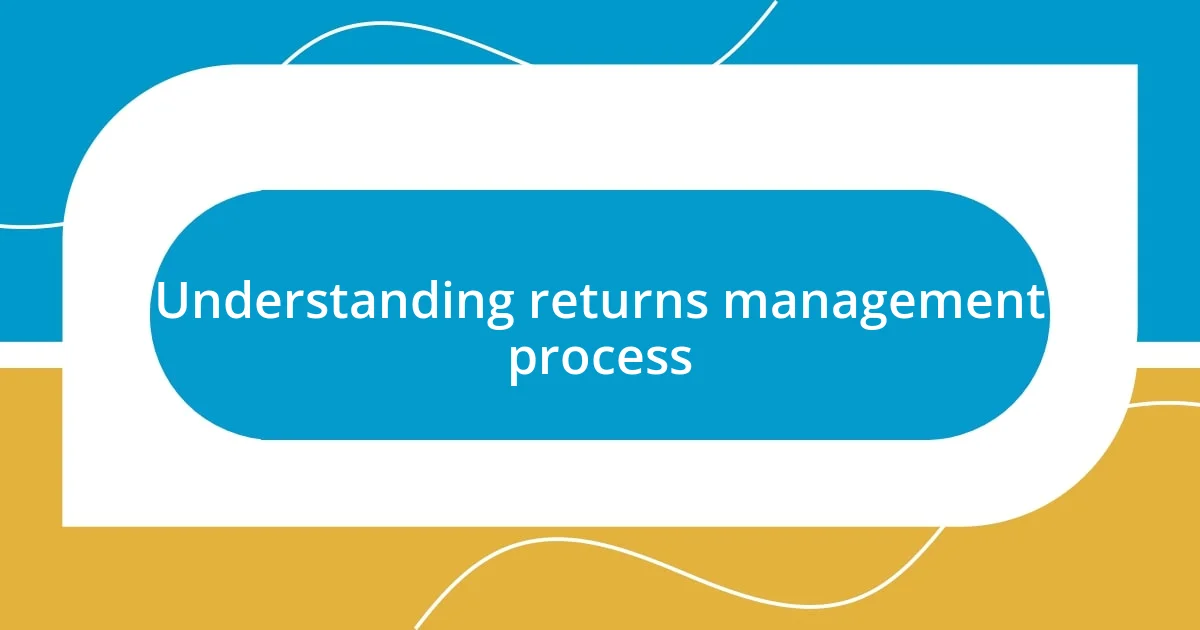
Understanding returns management process
Returns management is a multi-step process that involves accepting returned products, evaluating their condition, and deciding their fate—whether to restock, refurbish, or dispose of them. I recall a time when I had to manage a significant return from a busy season; it felt overwhelming at first. But by breaking it down into smaller tasks, I realized that each step, from assessing the returns to updating our inventory system, was crucial for maintaining efficiency.
Understanding this process means recognizing the emotional impact on customers as well. Think about it: how frustrating can it be to have a seamless shopping experience turn sour when a return is mishandled? Reflecting on my experiences, I learned that effective communication can turn a potential negative situation into an opportunity to build trust and loyalty. Keeping customers informed at each stage of their returns process not only eases their frustration but can also enhance their overall perception of our brand.
Moreover, a streamlined returns process significantly affects the overall business’s bottom line. Whenever I’ve encountered bottlenecks, it’s obvious how quickly costs can escalate, particularly if items are not efficiently categorized or processed. Have you ever considered how much time and money can be saved by integrating technology into returns management? I’ve seen firsthand how implementing tracking software improved our processing time and drastically reduced the number of returned items that languished in limbo.
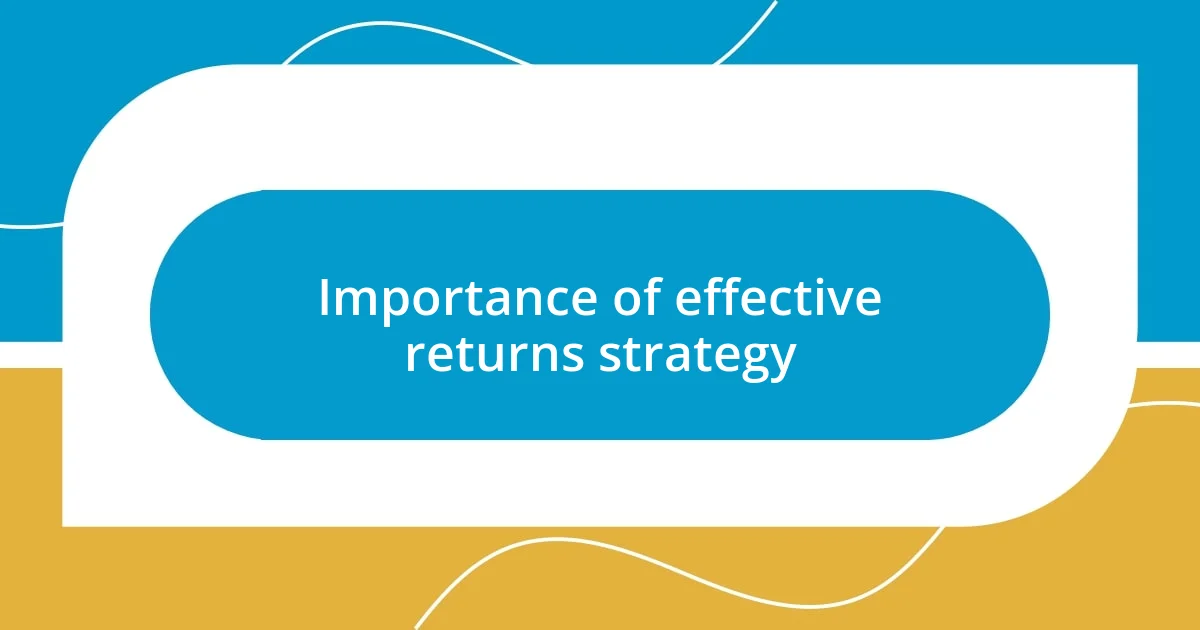
Importance of effective returns strategy
An effective returns strategy is essential for turning potential losses into valuable learning experiences. Reflecting on my past, I’ve seen how a well-structured returns process can actually enhance customer relationships. For instance, when I took the time to personally reach out to customers after a return, asking for their feedback, it not only showed them we cared but also provided insights that helped refine our offerings. This two-way communication often transformed an unhappy customer into a loyal one.
Additionally, I can’t stress enough the role of an effective returns strategy in brand reputation. I once had a friend who, after a frustrating return experience with a major retailer, vowed never to shop there again. This situation highlighted how a single poor interaction could significantly damage a brand’s credibility. In contrast, companies that manage returns effectively often find that customers are more likely to share their positive experiences, which can lead to new business through word-of-mouth.
Lastly, the financial implications of an efficient returns strategy cannot be overlooked. I remember analyzing our quarterly reports, where I discovered that a streamlined returns process helped us recover a remarkable percentage of the returned items. With that knowledge, we adjusted our strategy and invested in better training for our staff to ensure they understood the importance of handling returns efficiently. This proactive approach not only saved costs but also preserved inventory value and improved overall operational efficiency.
| Advantages of Effective Returns Strategy | Consequences of Poor Returns Strategy |
|---|---|
| Improves Customer Loyalty | Drives Customers Away |
| Enhances Brand Reputation | Damages Brand Credibility |
| Reduces Operational Costs | Increases Financial Losses |

Key metrics for returns analysis
To effectively analyze returns, certain key metrics can provide valuable insights into the overall efficiency and effectiveness of your returns management process. In my experience, measuring these metrics not only helps identify pain points but also reveals opportunities for improvement. For example, tracking the return rate—the percentage of items returned compared to total sales—can be a clear indicator of product quality or customer satisfaction issues.
Here’s a quick list of key metrics I consider essential for returns analysis:
- Return Rate: Measures the percentage of items returned relative to total sales.
- Return Reasons: Categorizing why items are returned can shed light on specific product issues or misalignments with customer expectations.
- Processing Time: The time it takes to receive and process a return can directly impact customer satisfaction and operational efficiency.
- Cost of Returns: Understanding the total costs involved in returns, including shipping, restocking, and lost sales, can highlight areas for cost reduction.
- Resale Rate: This metric indicates how many returned items can be restocked and sold again, which reflects the effectiveness of your returns processing system.
Another metric that caught my attention while refining our strategy was the customer feedback loop. I once implemented a system where we asked customers about their return experience. This feedback became a game changer. It not only made the customers feel valued but also provided our team with actionable insights. Reading through those responses, I remember the mix of frustration and hope; people wanted reassurance that their concerns were heard and addressed. Incorporating those insights into our returns process ultimately led to higher customer satisfaction and decreased return rates over time.
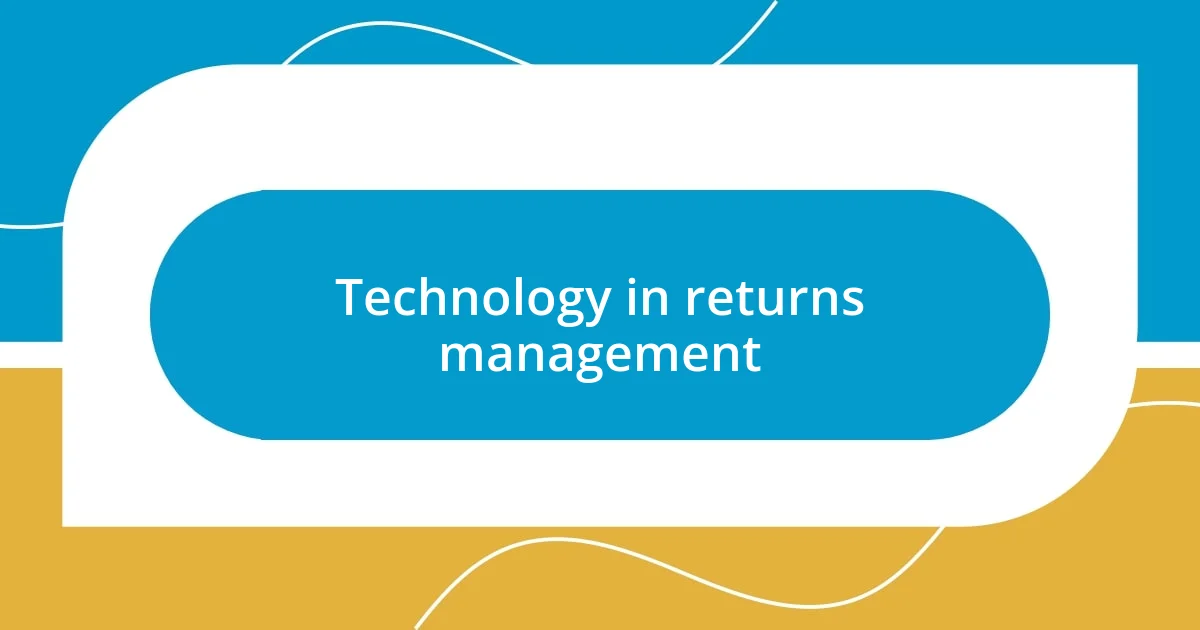
Technology in returns management
When it comes to technology in returns management, I’ve witnessed firsthand how the right tools can make a significant difference. For instance, I remember implementing a returns management software that streamlined our whole process. It not only automated return authorizations but also kept track of inventory in real-time. This system allowed us to quickly identify trends in return reasons, which helped us tackle product issues before they escalated. Isn’t it fascinating how a simple piece of technology can transform chaos into clarity?
I also found that integrating data analytics into our returns strategy opened up a new dimension of understanding for our team. By analyzing patterns, we could anticipate peak return periods and allocate resources accordingly. I recall a particularly busy season where we expected a influx of returns. Thanks to the data insights, we prepared in advance and maintained our customer service standards, which often become strained during those times. It’s moments like these that reinforce the importance of staying ahead with technology.
Lastly, I can’t help but emphasize the impact of mobile applications in enhancing the customer experience during returns. When we launched a user-friendly app that allowed customers to initiate returns effortlessly, it was a game-changer. Customers could simply scan their item, choose a return reason, and instantly get a shipping label. I received numerous messages from satisfied customers who appreciated the ease of the process. It’s a reminder of how technology can not only solve logistical problems but also create positive emotional connections with our brand. Isn’t that what we all aim for in a successful customer journey?
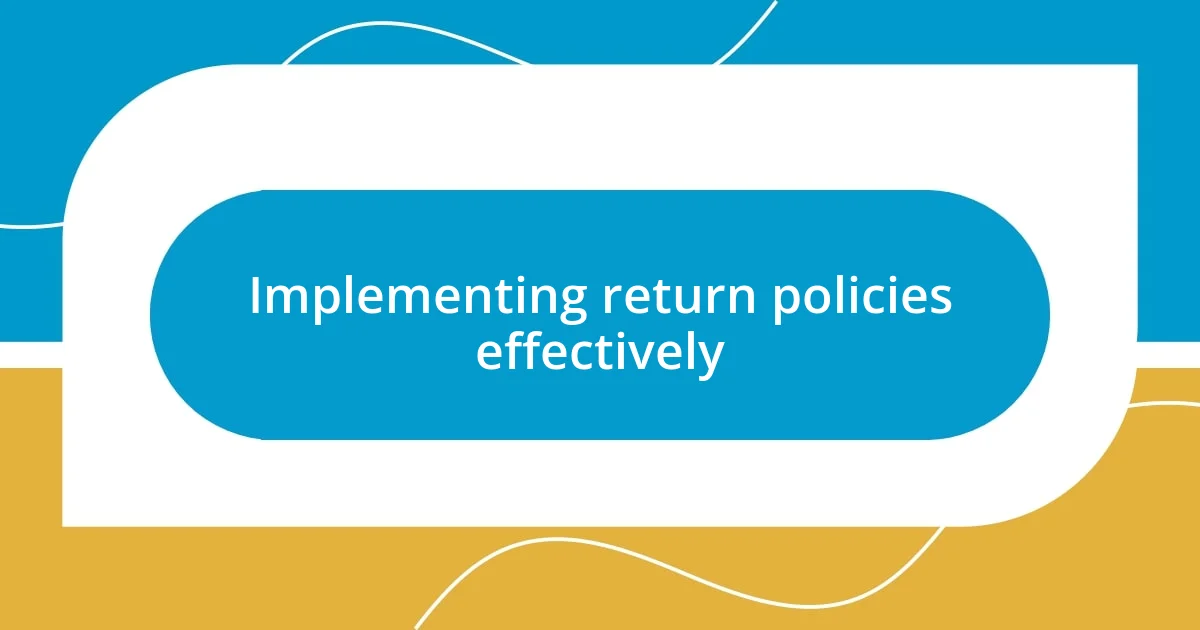
Implementing return policies effectively
Implementing effective return policies starts with clear communication. I remember when our team revamped our return policy; we ensured that it was easily accessible on our website and included straightforward language. It was amazing to see how just simplifying the terms reduced customer confusion significantly. Have you ever had to track down return information? Frustrating, right? Making that process easy can significantly enhance customer trust and satisfaction.
Another aspect that I learned effectively drives successful return policies is taking the customer’s perspective into account. During a brainstorming session, one of my team members suggested incorporating a “return concierge” service, which provided personal assistance to customers throughout the return process. This change led to an increase in positive feedback. It’s often the little touches, like a personalized email or a direct phone line to a helpful representative, that make customers feel valued. Wouldn’t you agree that feeling supported during a return can turn a potentially negative experience into a positive one?
Finally, consistently reviewing and adapting return policies can make all the difference. After noticing a spike in returns for specific items, we conducted a review of our policy and adjusted it accordingly. I can’t express how essential it is to stay responsive to emerging trends. Sometimes, it’s easy to stick to what we’ve always done, but is that really serving our customers best? Engaging with data, just as we did, allowed us to fine-tune our strategies and foster a more customer-centric approach that really resonates.

Training staff for return handling
One of the most important elements of returns management is training staff effectively for handling returns. I recall a workshop we held, focused entirely on role-playing different return scenarios. It was eye-opening to watch my team navigate various situations, from an upset customer wanting a refund to another who was just seeking clarity on our policy. After those sessions, I noticed a remarkable boost in confidence among my staff. Have you ever experienced how hands-on training can flip a stressful scenario into an empowering moment?
During our training, I emphasized the importance of empathy. I’d often share stories of frustrated customers whose experiences felt personal to me. A standout moment was when one of our team members connected with a customer over a shared experience of receiving the wrong item. By relating on that level, my colleague was able to turn the situation around. Isn’t it amazing how a little humanity in customer service can build stronger relationships and foster loyalty?
Regular refresher courses also became part of our training strategy. I initiated a monthly “return handling” session to discuss challenges and share success stories. I remember how one team member introduced a new way to guide a customer through the return process on the phone, which led to quicker resolutions. Checking in consistently not only keeps everyone sharp but also encourages innovation. Isn’t that the kind of environment we want to foster, one where team members feel comfortable sharing ideas and growing together?
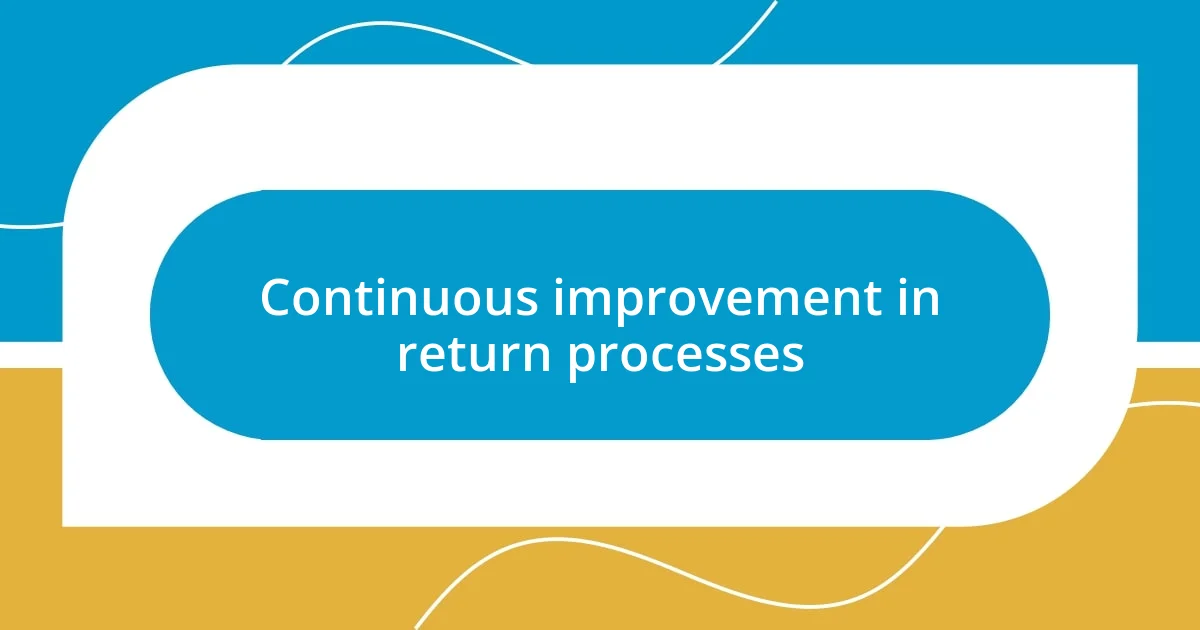
Continuous improvement in return processes
Continuous improvement in return processes requires a keen eye for detail and a commitment to listening to customers. I vividly recall a time when we revamped our return tracking system after discovering that customers were often left in the dark about the status of their returns. We responded by implementing real-time tracking updates via email, and the relief customers expressed was tangible. Have you ever tracked a return and just wished for a little reassurance? I think that feeling of being informed can transform anxiety into trust.
Another game-changer for us was gathering feedback after each return. I made it a point to reach out with a simple survey, asking customers about their experience. One insightful response revealed that many customers found our return labels confusing. Following this feedback, we simplified the labels, making orientations much clearer. It’s incredible how a little adjustment based on real user experience can enhance a process. Has feedback ever changed how you viewed a service? It certainly reshaped ours.
Finally, I believe in the power of peer benchmarking. In one of our strategy meetings, we devoted time assessing how competitors approached their return processes. The insights we gained were invaluable. Integrating innovative practices we had observed not only improved our efficiency but also sparked fresh ideas among our team. I still recall the excitement of sharing a new practice we discovered—a no-questions-asked return policy for loyal customers—which positively impacted our retention rates. Isn’t it inspiring to see what happens when we learn from one another?














